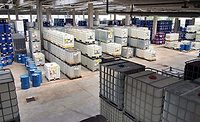The State of the "New Union" of the Coatings Industry
PCI Interview with Dan Murad, ChemQuest CEO and Keynote Speaker at CTT 2021

Dan Murad, the CEO of The ChemQuest Group, recently delivered the Keynote address at Coatings Trends & Technologies, PCI’s annual coatings event in the Chicago area. Dan’s presentation was titled, Fundamentals to Ensure Sustainable Growth: Strategic Insights for Mid-Decade Business Planning. Are you Ready for 2025? Below are some key points from his presentation. If you would like to view the entire keynote address, simply click here. Registration is free.
PCI: Taking a look at the macro environment, what are some key takeaways for post-COVID U.S. and global growth?
Murad: Currently, the coatings industry is undergoing a face-change. Unfortunately, for those of us wishing it will go back to the old “normal,” I don’t think that is going to happen.
Globally, we saw a decline in real GDP through the 2020 period. The U.S. real GDP growth decreased by 3.5% in 2020 after 14 years of growth. Fortunately, coming off the 2020 trough we are seeing global GDP grow at greater than 6% in most regions, apart from Europe.
COVID vaccinations are increasing, but with the Delta variant raising concerns and restrictions, it is unclear just how much that might mute the economy. So far durable goods, housing and other sectors have not seen much of an impact.
Central banks have been using quantitative easing as part of their stimulus, but lately we’ve seen a slowdown in that easing. There is also a stimulus package coming from the infrastructure bill, but it’s yet to be seen how much of that bill will earmarked for infrastructure.
The good news is that the economy seems to be on a very steep, “v”-shaped recovery. As part of that recovery, M&A has returned with a huge fervor. It’s truly been demand outstripping supply, and as a result, the multiples on an EBITDA basis have skyrocketed. It’s made a liar out of me because in 2008 I said we would never see multiples as high as back then.
Heading into 2022 we have a huge tailwind of pent-up demand. But we are facing many interruptions with the supply chain.
PCI: What are the causes of the current supply chain interruptions? And how long will it take to recover?
Murad: There were supply chain issues prior to COVID. We had lots of constraints on trucks and truck drivers, as well as shipping delays and rising costs. When COVID hit, industry did what we do best – demand decreased, so we started to crank back inventory. In fact, refining capacity was at about 60%. Not just refining capacity decreased – all across the value chain inventory was pulled back.
Right after the June-July 2020 period of COVID, demand came back rapidly. So rapidly that demand outstripped supply, and the industry supply chain couldn’t keep up.
Then, winter storm Uri hit and became a catastrophe, starting with shipping constraints and disrupting the entire supply chain. Petrochemical and chemical facilities were devastated by ice damage and power outages. In terms of raw materials, nearly 60% of ethylene and propylene capacity went offline for about two months. Those chemicals are the heart blood of the coating and specialty chemical industries.
Shortly after Uri, I was in Los Angeles, San Diego and San Francisco, and could see ships for miles. In the port of Los Angeles only 40% of the container ships were able to dock. The situation has barely improved. In late September 2021, there were 85 ships waiting at anchor or drifting along the coastline, according to the Marine Exchange of Southern California. The issue isn’t exclusive to California’s ports –there is a global back-up, with less than half of container ships arriving on time. Once they arrive, the problem is offloading and getting supply inland. The shortage of trucking and railcar shipping hasn’t helped with that. As a result, shipping costs have gone from $3.50 per mile to anywhere from $7 to $15.
PCI: What do you anticipate will happen with raw material costs in the near term and beyond?
Murad: Never in my 43 years in this industry have I experienced anything like this. Basically, the industry is saying, “We are out of stock.” Everything in terms of raw materials, from resins, epoxy resins, VAM and polyol, saw prices go up significantly.
At ChemQuest, we predict a 7% to 14% increase in raw material input costs. 14% for small to medium enterprises, and closer to 7% for the larger, multi-national coatings companies.
The main concern of the increasing costs of raw materials is inflation. It takes about 3-6 months for these shortages to get from the supply chain to the consumer.
PCI: What sectors have important demand drivers for the coatings industry? How were they affected by COVID and what is their outlook?
Murad: The three main sectors for the coatings industry are architectural, OEM and special purpose. We saw the industry decline 1.1% year over year in 2020 in terms of volume and 2.3% in value.
At ChemQuest, we are forecasting an increase across all three major market segments in 2021 — 4.2% for volume and 7% in value. Because of raw material constraints, there is pressure on gross margins. As I mentioned, that's 7% to 14%. On a weighted average basis, the increase is about a 9% increase in cost for the industry.
PCI: What are some important growth trends in the architectural coatings market?
Murad: The architectural industry fell by about 4% in both volume and value. At ChemQuest, we are forecasting that to go up by about 2.5% in volume and 5% in value for 2021.
Although inventory continues to be low, new and existing home sales are unexpectedly increasing. Household formation, which is a key demand driver for the coatings industry, is positive and increasing. That’s very good news, especially with the millennial generation, one of the largest generations, approaching its peak earnings period. Overall, demand for housing is high and supply is limited, which means pricing will increase. Over the last 12 months we’ve seen a 14% increase in home prices.
Real-estate construction was uneven through the COVID 2020 period. With stay-at-home and work-from-home orders shifting focus towards being comfortable at home, DIY repairs, remodels and maintenance saw a big jump, resulting in a large increase for architectural coatings. But we saw a decrease in the commercial sector — office spaces, entertainment complexes, stadiums, all sat unused and unmaintained.
Pro vs DIY was heavily shifted due to COVID. Before COVID, pro was at about 62% compared to 38% DIY. But during the pandemic, pro lost about 5% share. In the latter half of 2020 through 2021, pro has regained some of that market share and is up to 60%.
Overall, in the architectural sector, company-owned stores and big box stores were the real winners here. Within that, e-commerce saw a massive bump, increasing by 180% to 200%.
PCI: Similarly, what are the trends and opportunities in the OEM market?
Murad: In 2020, volume for the OEM industry decreased by 7.6% and value by 7%, but they’ve come roaring right back. ChemQuest forecasts a volume increase of 6.8% and a value increase of 8.6%.
One key trend in OEM is reshoring. Since 2010 there has be a significant amount of reshoring. As a result, more than 750,000 jobs have been created.
Along with new jobs, more opportunities are coming from technological advancements. Anything from automotive matte finishes, solar heat management, to self-healing coatings are helping to increase the OEM market.
PCI: What are the mega trends impacting the coatings industry today?
Murad: Everything from cyber-security to global health, reshoring, the electronic vehicle movement, biobased materials and climate change are all impacting the coatings industry.
One of the most exciting trends in coatings is smart coatings. These are coatings with unique functions beyond durability and aesthetics, based on external stimuli. There are many types, but to name a few there are self-cleaning, anti-icing, static-dissipative and even anti-microbial. This is the innovation that’s driving the coatings industry today.
Another innovative trend is using aerial robotics for the application of coatings. For example, a company called Apellix uses drones to reach unsafe or costly areas. The drones are equipped with different application and even cleaning features.
PCI: Can you comment on M&A activity since COVID? And what are the challenges for coatings companies as a result?
Murad: M&A has come screaming back. The primary challenge for coatings companies is the mature level of growth. In order to solve some of the challenges of this maturing growth, companies have turned towards M&A, increasing access to customers, new technologies, new regions of the world, and the synergies on the manufacturing and raw material side.
Since 2005 there have been 475 deals made in M&A, primarily dominated by Europe and North America. The top 10 coatings companies account for about 50% of those transactions.
2021 has seen an explosion in the number of deals. This is due to PE firms holding tremendous amounts of money on the sidelines, waiting to be invested. The stock market is staying relatively level, meaning investors can find higher returns in private funds, driving M&A to new and exciting heights. A case in point, EBITDA multiples are at an all-time high. I’ve seen numbers as high as 17 times. Not just in coatings, but adhesives as well.
PCI: What are some future trends as a result of COVID?
Murad: As a result of COVID, remote working/schooling from home has really shifted household formation away from urban areas towards the suburbs. Housing prices have started to appreciate significantly. With those two things, DIY projects have increased, including garages and basement finishing.
Another major trend is an accelerated movement away from brick and mortar. In my household, there isn’t a day that goes by without an Amazon package arriving. The popularity of e-commerce has had a positive impact on the coatings industry in terms of vehicle and warehouse application. Think about all the last-mile delivery vehicles that need to be painted.
COVID has been a catalyst for innovation and technology, particularly anti-viral and anti-microbial coatings.
The impact of COVID was uneven across economic sectors as well as in the coatings industry. But the good news is that sectors that underperformed in 2020 are among the best performers over the next 12 months.
PCI: What is required for companies to maintain future business growth?
Murad: The key to staying ahead here is seeking new opportunities and collaboration. For example, talking about global health, the National Science Foundation put an accelerated program in place to develop anti-viral technologies. Paint and coatings formulators submitted a record number of applications.
In terms of improving supply chain resilience, I see four key factors.
-
Firstly, increasing visibility and data sharing across the entire supply network.
-
Secondly, agility – increasing the speed at which the supply network can respond to challenges.
-
Thirdly, diversification of the supplier base.
-
Lastly, implementing a contingency plan allows for intelligent planning and maximum control.
As a concluding statement, if you think the current chaotic situation we are living in as a result of COVID and the supply constraints are going to go away any time soon, I have another message coming to you…that’s not going to happen.
For more information, visit www.chemquest.com.
Looking for a reprint of this article?
From high-res PDFs to custom plaques, order your copy today!









